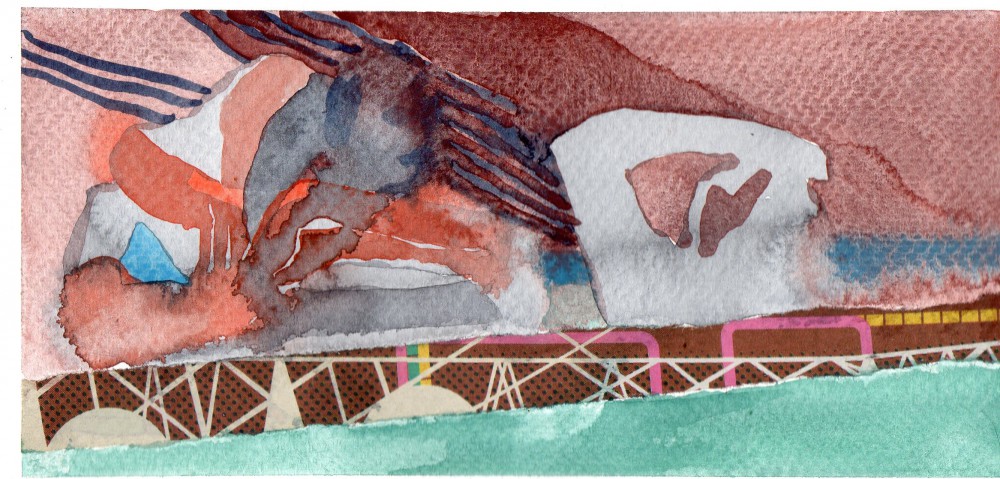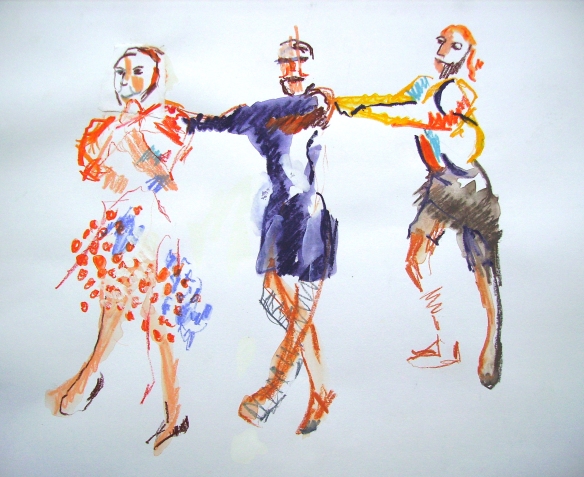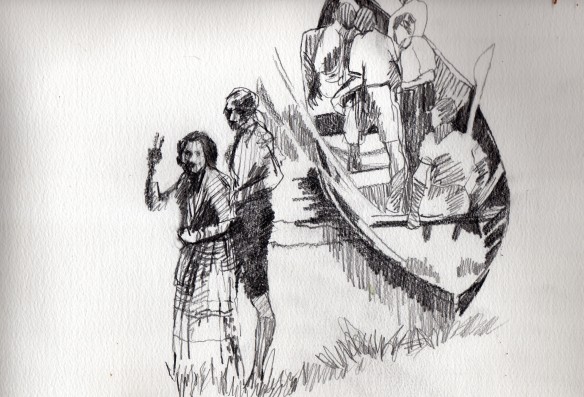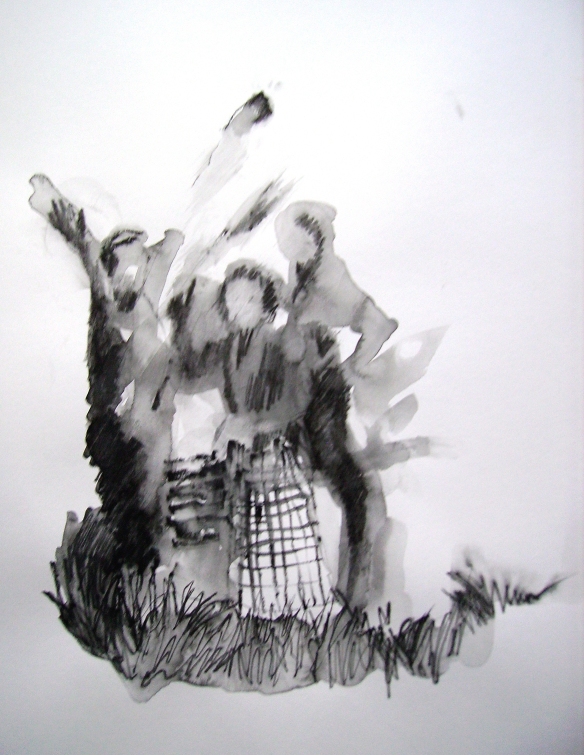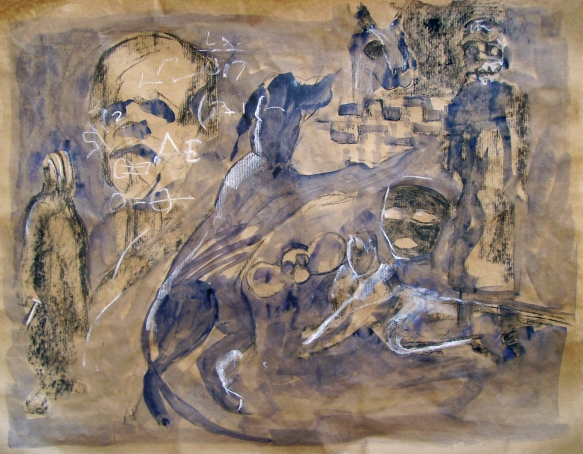Looking back on the sketches I made in Catacombe dei Capuccini, they seem to contain a lot of character and detail. It’s a different thing when you start to use the sketches as a basis for further work. Then it becomes apparent how relatively little information they contain. I’ve been making ink line and watercolour wash drawings, as a way of getting to know the shapes and forms. These naturally create variations on the form, which sometimes disappointed me at first, but then I realised it’s a way of claiming the images for myself, so I eventually get free of the actuality and take off in another direction. Another possibility will be to make 3D figures and use them as models for drawing. A couple of examples here can be compared with the previous post of the original sketches. I used a twig to draw the ink line, which produces some clumsiness in places, but has a different vitality from a pen line. So far, I am going with subdued colour that echoes the aged appearance of the mummies’ clothing.
Category Archives: Drawing
The mummies of Palermo
Last week a long weekend in Palermo to visit something I have wanted to see ever since I first heard about it – Catacombe dei Cappucini. This extraordinary underground burial chamber contains thousands of mummified bodies, the first mummified in the 16th century, the last in the early twentieth. It is well catalogued in websites, so worth looking on a search engine to see the variety and arrangement of the remains. There are several broad corridors, categorized for the monks, priests, men, women and children. Out of respect and to help preserve the bodies, no photography is allowed, so I spent my time drawing. (Incidentally, I don’t understand why some visitors seem proud of themselves when they manage to flout the no photos request.) Each mummy has an individual character, and the clothing enhances the differences. It is a truly astonishing and humbling experience to be allowed to see this.
I have about 25 drawings and some diagrams, so I’m not going to post them all, but these are probably my favourites, the last (below) a marvellously simple form – not quite fully skeletonised and bound in a plain robe.
The drawings were done in black ballpoint in a small Moleskine sketchbook. (There is a ghost image in these scans which is the drawing on the next page showing through.)
Cemetery art trail
A while ago, I visited West Norwood cemetery in south London where, through July, they had an art trail of 21 pieces responding to the architecture, layout and purpose of the cemetery. It’s well worth a visit without any added art, being one of a number of large Victorian built cemeteries on the outskirts of London that are monumental in scale and intention..
For me, several of the artworks were a bit disappointing, lacking ambition considering the landscaping and visual richness of the site. The themes of remembering, celebrating and mourning lend themselves so broadly to visual interpretation, as can be seen from the many ways in which ordinary people memorialise their losses. One part of the cemetery is a special section for the Greek population of London in the nineteenth century, where I was particularly impressed by this mourning figure. You can only view it from below due to the height of the stone catafalque.
Graves for children and young people are particularly touching, but also tend to be more imaginatively decorated than those for adults.
But I love this idea of passing into eternity, however one imagines it, accompanied by beloved companions.
And this colourful grave is a fabulous variation on the traditional funeral flowers.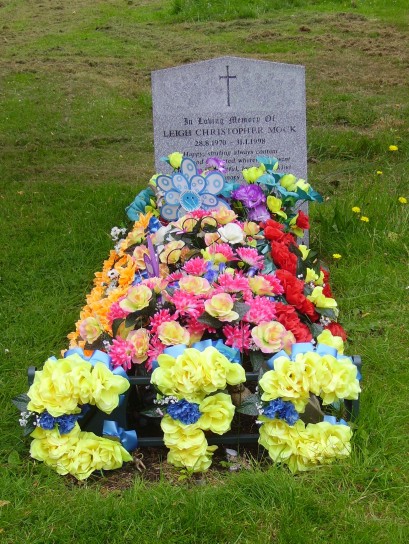
This portrait is one the art pieces I found particularly successful, combining a classic pose from christian painting and sculpture with an iconography of daily life. (I will credit the artists whose work is shown below when I find my art trail map.)
Within the structure of a standard Victorian monument, the subtlety of this next piece was almost easy to miss.The small ceramic plaques.celebrate the memory of two otherwise unremarkable people whose names the artist chose from the old registers, together with small votive objects, bottles and bowls containing symbolic materials. I wasn’t able to get the full detail of the plaques; the old fashioned handwriting from the register is reproduced in ceramic glaze.
All this material links for me to the themes of memory and forgetting that I have been working with in my own projects. I have so far done a brush drawing and a watercolour painting bringing some of the imagery together, which I will record in the blog later when the series is further on.
Although my photo fails to do it justice, I can’t resist adding this hanging ‘wreath’, using the now ubiquitous fashion of spelling out words in flowers. Its simple slogan perfectly expresses my own feelings about how bereavement echoes down the years.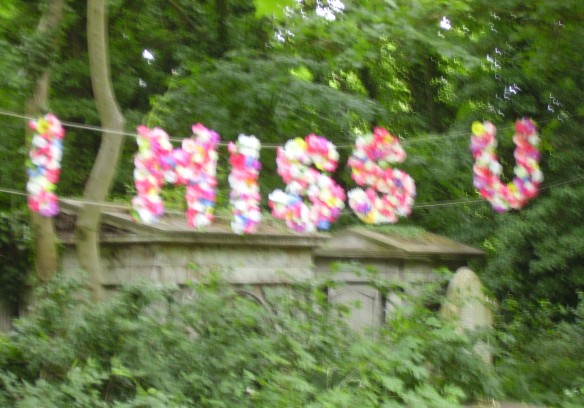
Artists Open Houses, Brighton Festival;
There have been no posts during May as I’ve been totally preoccupied with my open house. I forgot how much work is involved in transforming the home acceptably into a gallery setting and trying to keep it in order throughout the month, although I was only open to the public on Sundays. This was a good experience for me: as a solo painter, I get fewer visitors than houses that open with a wide range of artists and makers, but the people who come are very interested in painting and do look carefully at the work, which has resulted in a pleasing number of sales. This picture shows the front of the living room with the Fighting Cats paintings on the wall. The ducks and the sculpture are things I own. Although I have to clear the rooms where I’m showing, it’s nice to retain some personal items that give a broader sense of who I am and what I like, which in my case includes a lot of plants and books as well as favourite objects. The Significance of Bears paintings were hung together on the opposite wall.
This picture shows the front of the living room with the Fighting Cats paintings on the wall. The ducks and the sculpture are things I own. Although I have to clear the rooms where I’m showing, it’s nice to retain some personal items that give a broader sense of who I am and what I like, which in my case includes a lot of plants and books as well as favourite objects. The Significance of Bears paintings were hung together on the opposite wall. 
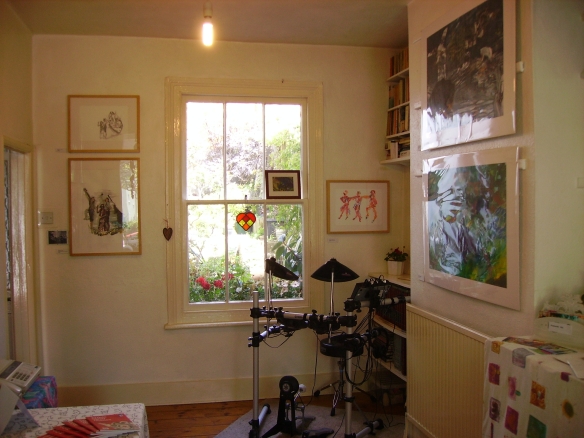
The ground floor is one big through room: at the back there are pictures from the Family Photos, Brown Paper Drawings and Bears series. I couldn’t bring myself to dismantle the electronic drum kit, thinking I would probably find it difficult to put it back together. Sadly, few visitors seized the chance to release their inner rock god, although I was happy for anyone to play.
The studio was arranged more informally. There were very few framed or mounted pictures up there. Works on show were both finished and unfinished, I also included a few that I consider unsuccessful but that help to explain thought processes and links between the works. 
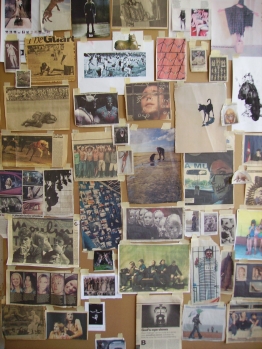
My photo wall was left in place – this consists of found photos I have clipped and saved over a period of many years, and the images contribute ideas to a variety of works. The Brown Paper Drawings, for example, are entirely composed of images from the photo wall.
The main problem I’ve always had with doing open house is that it diverts my attention and energy from doing new work. This year I have made an effort to get going on a new project and now look forward to reclaiming the studio space, making a mess, pursuing new strands of work. My thanks to all the visitors who came, it is not only sales that make this kind of exhibition worthwhile, but general interest and feedback, and the occasional person who says it has inspired them to try something painterly. The recent a-n artists’ survey reveals that the most highly valued reason for exhibiting is to share the work with the public.
Messing in boats
These are from the Family Photos series relating to photos from the Swiss holiday in 1937 where my parents first met. This is an appealing but fairly straightforward image – I like the high viewpoint. So far I’ve only done drawings relating to it, most likely it would lend itself to a much larger mixed media piece.
Brown paper drawings
I have a huge archive of found photos, collected for purely visual interest or for my interest in the content, and also for teaching purposes, so there is reference material on any subject students might choose. The majority are clippings and tear sheets from newspapers and magazines, but there are also photos taken by me, friends or family members, and a range of postcards – views, artwork and old pictures.
The brown paper drawings are what I call thinking out loud – that is, thinking on to paper. Initially I chose favourite images from my collection, with written comments and associations; gradually themes began to emerge. The drawings are charcoal, acrylic wash and chalk on brown paper, each approx. 22x28in (56x71cm).
